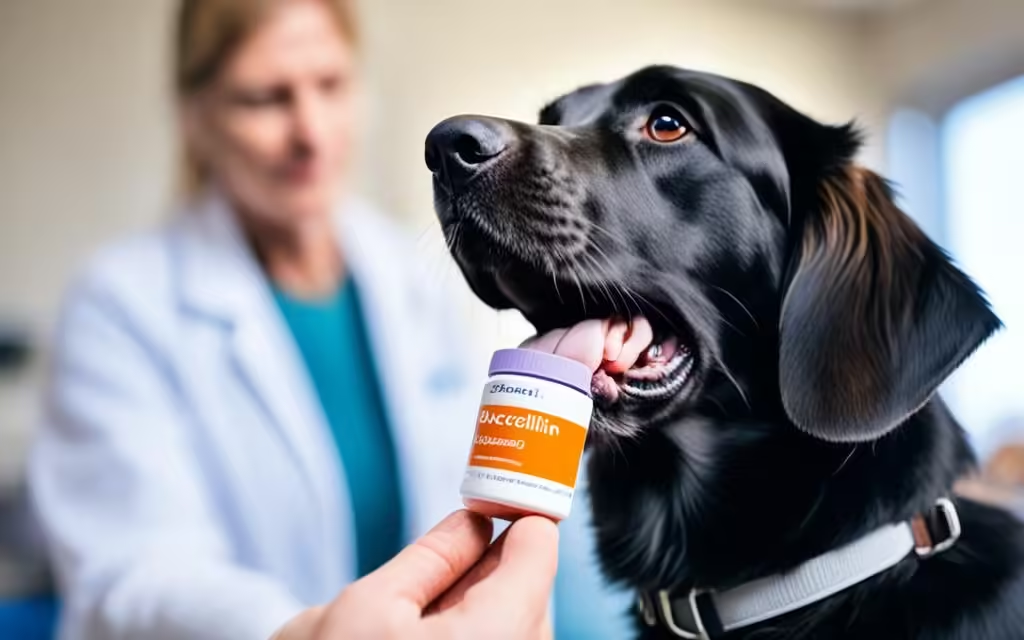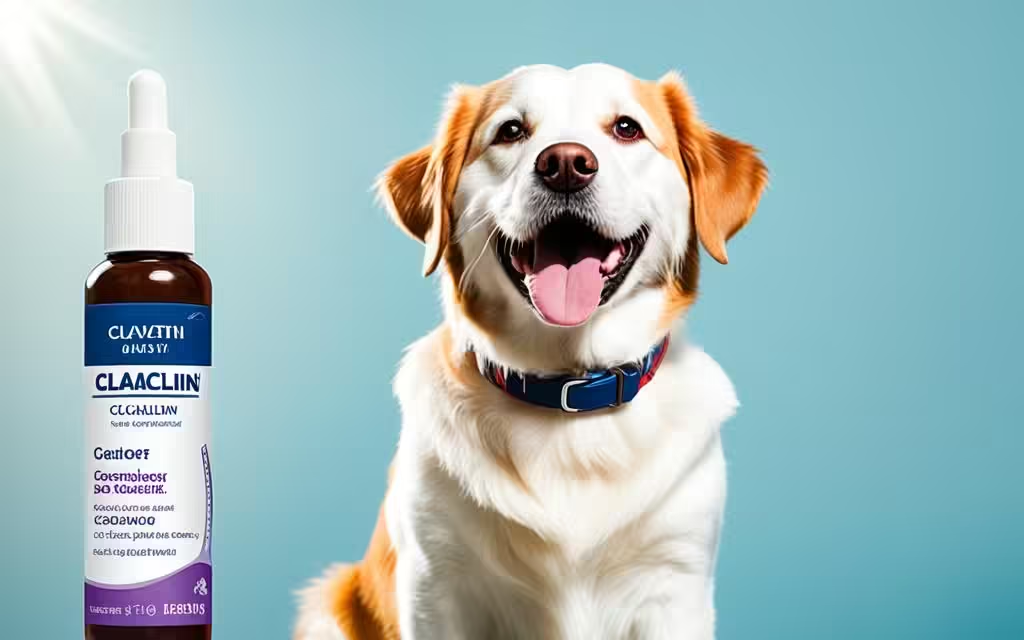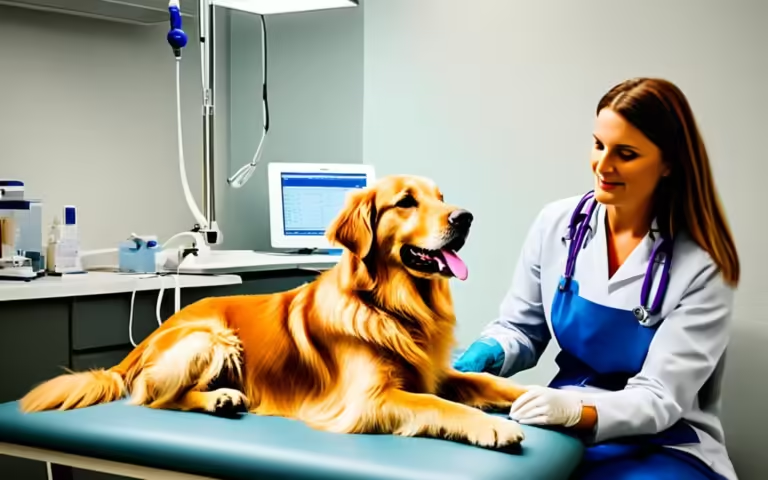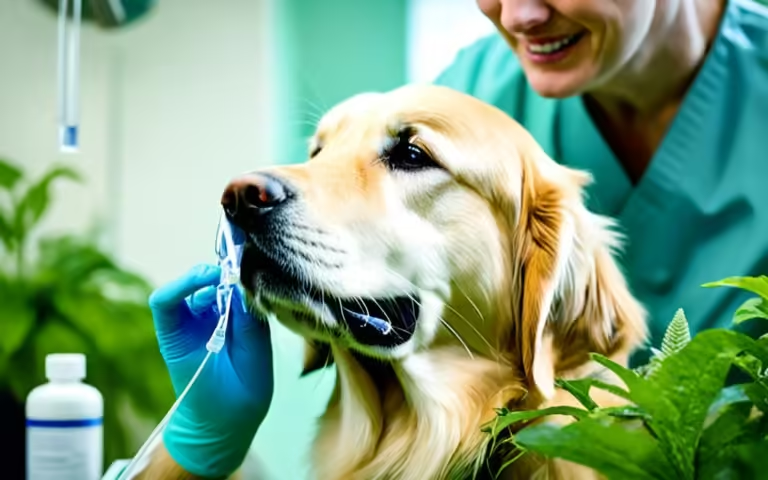Clavacillin for Dogs: Antibiotic Treatment Guide
Did you know Clavacillin is a strong antibiotic for dogs? It fights many types of bacteria that can make dogs sick1. This medicine, also called amoxicillin-clavulanate, is often used by vets for different dog infections. These can be from the skin, soft tissues, or even the urinary tract.
Key Takeaways
- Clavacillin is a potentiated penicillin antibiotic effective against a wide range of bacteria in dogs.
- The recommended dosage for dogs is 6.25 mg per lb of body weight, twice a day12.
- Treatment duration can vary from 5-7 days for skin infections to up to 21 days for deep pyoderma, and 10-14 days for urinary tract infections12.
- Clavacillin comes in different tablet strengths and an oral suspension for easy dosing12.
- Clavacillin may interact with other antibiotics and medications, so it’s important to discuss with your veterinarian1.
Clavacillin is great for treating many bacterial infections in dogs. It’s easy to give to your pet because it comes in different forms. As you learn more about Clavacillin, you’ll see how it can help keep your dog healthy and happy.
Table of Contents
What is Clavacillin?
Clavacillin, also known as amoxicillin clavulanate or amoxiclav, is a broad-spectrum antibiotic. It combines amoxicillin trihydrate with clavulanate potassium3. This mix is strong against many bacteria, like Staphylococcus, Streptococcus, and E. coli3.
Common Names
Clavacillin is the brand name for this antibiotic. It’s also called amoxicillin clavulanate or amoxiclav435.
Drug Type
Clavacillin is a penicillin type. It’s a β-lactam antibiotic made for pets, like dogs and cats3.
Used For
Clavacillin treats many bacterial infections in pets. It helps with skin infections, wounds, and more4. It’s also good for dog dental problems and cat urinary infections.
Clavacillin Drops have 50 mg of amoxicillin and 12.5 mg of clavulanic acid per mL. After mixing, you get 15 mL of suspension4.
“Clavacillin is a broad-spectrum antibiotic that is effective against a wide range of aerobic and anaerobic bacteria, including those that produce β-lactamases.”
Clavacillin for Dogs: Mode of Action
Clavacillin combines amoxicillin and clavulanic acid to fight bacteria. Amoxicillin stops bacteria from building their cell walls, killing them. Clavulanic acid stops enzymes from breaking down amoxicillin, making it work better2.
This mix of amoxicillin and clavulanic acid in Clavacillin fights many kinds of bacteria, even those that resist antibiotics. It’s a strong treatment for bacterial infections in dogs6.
Amoxicillin kills bacteria by weakening their cell walls. Clavulanic acid stops enzymes from breaking down amoxicillin7.
Together, these two parts make Clavacillin work against many bacteria, even those amoxicillin can’t fight alone. It’s great for treating many infections in dogs, like skin infections and urinary tract infections.

“Clavacillin’s unique mechanism of action, combining the antibacterial properties of amoxicillin with the beta-lactamase inhibition of clavulanic acid, allows it to be an effective treatment for a wide range of bacterial infections in dogs.”
| Antibiotic Component | Mechanism of Action |
|---|---|
| Amoxicillin | Disrupts bacterial cell wall synthesis, leading to cell death |
| Clavulanic Acid | Inhibits beta-lactamase enzymes, preventing the breakdown of amoxicillin |
Clavacillin uses amoxicillin and clavulanic acid to target different bacteria. This makes it a strong choice for vets treating bacterial infections in dogs7.
Benefits of Clavacillin for Dogs
Clavacillin is a broad-spectrum antibiotic that offers many benefits for dogs. It combines amoxicillin and clavulanic acid to fight bacteria that are hard to beat. This makes Clavacillin great for treating many dog infections, like gum disease, skin infections, and more.
Clavacillin is great for fighting a wide range of bacterial infections in dogs. It works against many types of bacteria, even those that amoxicillin alone can’t handle. This means Clavacillin can tackle tough infections that don’t respond to other treatments.
| Indication | Dosage for Dogs | Duration of Treatment |
|---|---|---|
| Skin and Soft Tissue Infections | 6.25 mg/lb of body weight twice a day | 5-7 days, or for 48 hours after symptoms subside; deep pyoderma may require up to 21 days |
| Periodontal Disease | 6.25 mg/lb of body weight twice a day | Variable, depending on severity and response to treatment |
Clavacillin treats many bacterial infections in dogs, reducing the risk of complications and speeding up healing. Its wide range of action and ability to fight resistant bacteria make it a key tool for vets.
“Clavacillin is a potent antibiotic that has been shown to be clinically effective in treating a wide range of bacterial infections in dogs. Its combination of broad-spectrum activity and the ability to overcome resistance makes it a valuable asset for veterinary practitioners.”
Clavacillin improves the health and life quality of dogs by treating various infections. It helps reduce the risk of complications and supports faster recovery8. Its effectiveness and versatility make it a valuable addition to the vet’s toolkit for fighting dog infections.
Administering Clavacillin to Dogs
Clavacillin is a common antibiotic for dogs with bacterial infections9. Dogs need 6.25 mg/lb of body weight, given twice a day. This dose is key to fighting infections and stopping bacteria from becoming resistant9.
Dosage Chart
| Dog Weight | Dosage (Twice Daily) |
|---|---|
| 10 lbs | 62.5 mg |
| 20 lbs | 125 mg |
| 40 lbs | 250 mg |
| 80 lbs | 500 mg |
Clavacillin is used for skin and soft tissue infections, and for gum infections. It’s given for 5-7 days or until symptoms go away, up to 30 days9. For deep infections, treatment might last up to 21 days9. If there’s no improvement in 5 days, stop the treatment and check again.
Frequency and Direction of Use
Give Clavacillin orally, twice a day, with or without food10. The liquid form should be kept cold and thrown away after 10 days10.
Missed Dose Guideline
If you miss a dose, give it as soon as you remember9. But don’t double the next dose9. Following the schedule is key to treating your dog’s infection.

Always follow your vet’s instructions when giving Clavacillin to your dog9. The right dose and treatment time are important for fighting infections and preventing resistance9. Knowing how to give Clavacillin right helps pets get the best care91011.
Potential Side Effects and Precautions
Clavacillin is a mix of amoxicillin and clavulanate, used to fight off bacterial infections in dogs12. It’s a common treatment, but it can have side effects and needs careful use.
Adverse Reactions
Side effects of Clavacillin in dogs include not wanting to eat, feeling tired, vomiting, and diarrhea13. Rarely, dogs might have allergic reactions like skin rashes, swelling, or trouble breathing. If these serious signs show up, see a vet right away.
Pregnant/Lactating Dogs
Clavacillin’s safety in pregnant or nursing dogs is not fully known. Be careful if you’re giving it to them, and talk to your vet first.
Don’t use Clavacillin on small animals like rabbits, guinea pigs, chinchillas, or hamsters. It can also interact with other medicines, such as certain antibiotics, methotrexate, probenecid, and warfarin. Always check with your vet before giving Clavacillin or any other medicine to your dog.
| Potential Side Effects of Clavacillin in Dogs | Precautions |
|---|---|
|
|
Knowing about the possible side effects and precautions helps pet owners use Clavacillin safely and effectively in their dogs121314.
“Responsible use of antibiotics, such as Clavacillin, is essential to prevent the development of antibiotic-resistant bacteria and ensure the continued efficacy of these important medications.”
Comparison with Similar Antibiotics
Clavacillin, also known as Clavamox, is a top choice for treating dogs with antibiotics. It combines amoxicillin and clavulanic acid, making it stronger than amoxicillin alone15. This mix works well against many bacteria, even those resistant to amoxicillin15.
Clavacillin is also budget-friendly, making it easy for dog owners to afford15. It’s a cost-effective option for vets too. But, it can cause side effects like stomach upset, allergic reactions, and kidney issues in rare cases15.
Efficacy
Clavacillin beats out other antibiotics like amoxicillin and others in treating infections15. It’s great for skin infections and skin problems with pus15. The clavulanic acid in it helps fight Staphylococcus bacteria, making it a top choice for dogs10.
Cost
Clavacillin is cheaper than similar antibiotics15. It comes in different forms like oral suspension, tablets, and chewables for humans10. This variety lets vets and owners pick the best and cheapest option for their dogs10.
Side Effects
Clavacillin is usually safe but can cause diarrhea, vomiting, and less appetite16. These issues are common with other antibiotics too, like azithromycin and cephalexin16. Always watch how your dog reacts to it and tell your vet if there are any bad reactions.
In summary, clavacillin, or Clavamox, is a dependable and affordable antibiotic for dogs. It’s proven effective against many infections. While it may have some side effects like other antibiotics, its benefits make it a favorite among vets and owners151016.
clavacillin for dogs
Clavacillin is a brand-name antibiotic that combines amoxicillin and clavulanic acid. It’s used to fight bacterial infections in dogs. This antibiotic works against many types of bacteria, including those that resist antibiotics. The FDA has approved it for dogs and cats to treat infections in the skin, soft tissues, and urinary tract.
Dogs need 6.25 mg/lb of body weight twice a day. Clavacillin is great for treating skin and soft tissue infections in dogs. It works against bacteria like Staphylococcus aureus and E. coli17. For cats, it’s used to treat skin infections and should be given for 5-7 days or until symptoms go away17.
Clavacillin is a good choice instead of Clavamox or Augmentin for dogs and cats. It has Amoxicillin and Clavulanate Potassium to fight infections better. It’s used for infections in the skin, urinary tract, and other areas.
| Tablet Strength | Amoxicillin Activity | Clavulanic Acid |
|---|---|---|
| 62.5 mg | 50 mg | 12.5 mg |
| 125 mg | 100 mg | 25 mg |
| 250 mg | 200 mg | 50 mg |
| 375 mg | 300 mg | 75 mg |
Clavacillin comes in different strengths for dogs, like 62.5 mg, 125 mg, 250 mg, and 375 mg. You can give it with or without food to help your pet’s stomach. Always follow your vet’s instructions on how to give it to your pet.
Some dogs and cats may get sick after taking Clavacillin, like feeling tired, vomiting, or having diarrhea17. Be careful with it if you’re allergic to penicillin. Some pets like rabbits and guinea pigs might get diarrhea from it.
Many people are happy with Clavacillin for treating infections in dogs and cats. It has Amoxicillin and Clavulanate Potassium to fight infections18.
“Clavacillin has been a game-changer for my dog’s skin infection. The vet recommended it, and it cleared up the issue quickly and effectively.”
In summary, Clavacillin is a powerful antibiotic for dogs. It’s a reliable and easy option for pet owners and vets.
FDA Approval and Availability
Clavacillin is a brand name for amoxicillin and clavulanate potassium tablets. It’s approved for dogs and cats by the FDA20. You can find it in different strengths like 62.5 mg, 125 mg, 250 mg, and 375 mg. It comes in strip packs or cartons. You need a vet’s prescription to get it.
Clavacillin is a generic version approved by the FDA under ANADA # 200-592. It’s a copy of a drug that was approved before. The original drug, Clavamox, has been used for over 30 years for dogs and cats22.
Clavamox, the brand name, is a top pet medicine in the U.S. It has been used for three decades in dogs and cats. Now, Clavacillin is a cheaper option for pet owners.
| Clavacillin Tablet Strengths | Availability |
|---|---|
| 62.5 mg | Strip packs or cartons |
| 125 mg | Strip packs or cartons |
| 250 mg | Strip packs or cartons |
| 375 mg | Strip packs or cartons |
FDA approved clavacillin is easy to get with a vet’s prescription. It’s a cheaper choice for pet owners who need this antibiotic for their pets202221.
Administering Clavacillin: Best Practices
It’s important to give Clavacillin safely and correctly to your dog. Vets usually suggest giving it by mouth, either as a pill or a liquid for smaller dogs. If your dog won’t take the medicine, you might hide it in a bit of food23.
Make sure your dog finishes all the medicine, even if they get better fast. Stopping the medicine early or missing doses can cause the infection to come back or make bacteria harder to treat25. You should check in with your vet often to make sure the infection is gone.
- Follow your vet’s advice closely when giving Clavacillin23.
- Finish the full treatment, even if your dog recovers quickly23.
- Talk to your vet if you miss a dose or have questions25.
- Watch your dog for any bad reactions, like stomach problems or allergies, and tell your vet right away24.
“It is crucial to follow your veterinarian’s instructions regarding Clavacillin usage to avoid antibiotic resistance and prolonged infections.”23
Following these steps will help make sure Clavacillin is given safely and effectively. This will help your dog get better and stop bacteria from becoming resistant to antibiotics2325.
Monitoring Treatment Progress
When giving Clavacillin to your dog, watch their progress closely. Most dogs start to get better in 24-48 hours26. But, make sure they finish the whole treatment as your vet says, which can be 5-7 days for some infections or up to 21 days for serious ones26.
If your dog doesn’t get better after 5 days of Clavacillin, talk to your vet. They might suggest stopping the medicine and checking again. It’s important to keep up with vet visits to make sure the infection is gone and the antibiotic worked26.
Signs of Improvement with Clavacillin
As Clavacillin helps your dog, you might see these signs:
- Less swelling and inflammation
- Less discharge or pus
- Better appetite and energy
- Lower fever or no fever
- Healing of skin or wounds
Watching for these changes helps you know if Clavacillin is working. This way, you can be sure your dog is getting better26.
| Key Factors to Monitor | Timeframe for Improvement |
|---|---|
| Reduction in inflammation and swelling | 24-48 hours |
| Decreased discharge or pus | 2-3 days |
| Improved appetite and energy levels | 2-4 days |
| Fever resolution | 1-2 days |
| Healing of skin lesions or wounds | 5-7 days |
The time it takes for improvement can vary based on your dog’s condition and the infection. Always follow your vet’s advice and finish the Clavacillin to help your dog fully recover.
Watching your dog’s Clavacillin treatment closely and looking for signs of getting better helps you see if it’s working. This way, you can make sure your dog is getting better. Always talk to your vet if you have questions or concerns about your dog’s treatment and health26.
Drug Interactions and Contraindications
Clavacillin is a common antibiotic for dogs but can interact with other drugs and may not be safe for certain health conditions27. It’s important for pet owners to tell their vet about any other medicines or supplements their dog is taking27.
Don’t give Clavacillin to dogs that are allergic to penicillins or cephalosporins. Also, be careful with pregnant or breeding animals as its safety in these cases is not known28.
When using Clavacillin with other medicines, watch closely as it could change how they work or be harmful to organs. Always tell your vet about all the medicines and supplements your dog is on to use Clavacillin safely29.
| Conditions that Contraindicate Clavacillin Use in Dogs |
|---|
| History of allergic reaction to penicillins or cephalosporins |
| Pregnancy or breeding status (safety not determined) |
Knowing about Clavacillin’s drug interactions and contraindications helps pet owners and vets use it safely and effectively for treating bacterial infections in dogs272829.
Conclusion
Clavacillin is a strong antibiotic used for many bacterial infections in dogs. It’s great for treating skin, soft tissue, and urinary tract infections, among others. The mix of amoxicillin and clavulanic acid in Clavacillin fights off many kinds of bacteria effectively.
Clavacillin is usually safe and well-suited for dogs when given correctly. The right dose depends on the dog’s weight, making sure the medicine works best. Owners may see their pets start to get better in 2-3 days. But, it’s important to finish the whole treatment for the best results.
Clavacillin doesn’t work on viral or fungal infections, but it’s great for bacterial ones in dogs. By following the vet’s advice and giving Clavacillin as told, pets can get better from bacterial infections. The main points are Clavacillin’s benefits and the need to use it as the vet says for dogs.
FAQ
What is Clavacillin?
How does Clavacillin work?
What types of infections can Clavacillin treat in dogs?
What is the recommended dosage of Clavacillin for dogs?
What are the potential side effects of Clavacillin in dogs?
Is Clavacillin safe for pregnant or lactating dogs?
How does Clavacillin compare to other antibiotics for dogs?
Where can I get Clavacillin for my dog?
How soon should I see improvement in my dog’s condition after starting Clavacillin?
What should I do if my dog misses a dose of Clavacillin?
Source Links
- Clavamox for Dogs: All You Need to Know About This Antibiotic – One Vet
- Clavacillin (Amoxicillin Trihydrate and Clavulanate Potassium) Tablet
- No title found
- No title found
- Amoxicillin-Clavulanic Acid | VCA Animal Hospitals
- Amoxicillin + Clavulanate for Dogs and Cats | PetPlace.com
- Clavamox® for Dogs and Cats
- Clavacillin (Amoxicillin/Clavulanate Potassium) Veterinary Tablets
- Clavamox For Dogs: Usage, Dosage, & Side Effects | BetterVet
- Amoxicillin-clavulanic acid (Clavamox, Augmentin, Clavacillin)
- Clavacillin (amoxicillin and clavulanate potassium) Oral Suspension
- Uses, Dosage & Side Effects
- Amoxicillin | VCA Animal Hospitals
- 1800PetMeds
- A Guide to the Top Antibiotics for Dogs – Whole Dog Journal
- Clavacillin® (amoxicillin and clavulanate potassium tablets), USP
- Clavacillin (amoxicillin clavulanate)
- Clavacillin (Amoxicillin Trihydrate/Clavulanate Potassium) 250mg | Broad Spectrum Antibiotic For Dogs | Medi-Vet
- Amoxicillin for Dogs and Cats
- FOI Summaries for Approved and Conditionally Approved Animal Drugs
- Clavamox For Dogs (Uses & Side Effects) | Dutch
- Clavamox For Dogs: Safe Dosages And Uses
- Clavamox for Dogs: What it Is and How To Use it Safely
- How to Administer Prescription Antibiotics to Pets
- Treating Resistant Skin Infections in Dogs
- Clavamox Chewable Tablets for Animal Use – Drugs.com
- Clavacillin (amoxicillin trihydrate/clavulanate potassium) Veterinary Tablets for Animal Use – Drugs.com
- Clavamox for Dogs: Uses, Dosing, Side Effects | Great Pet Care
- Common Antibiotics for Dogs: Understanding Their Uses and Benefits
- Understanding Clavamox: What You Need to Know







